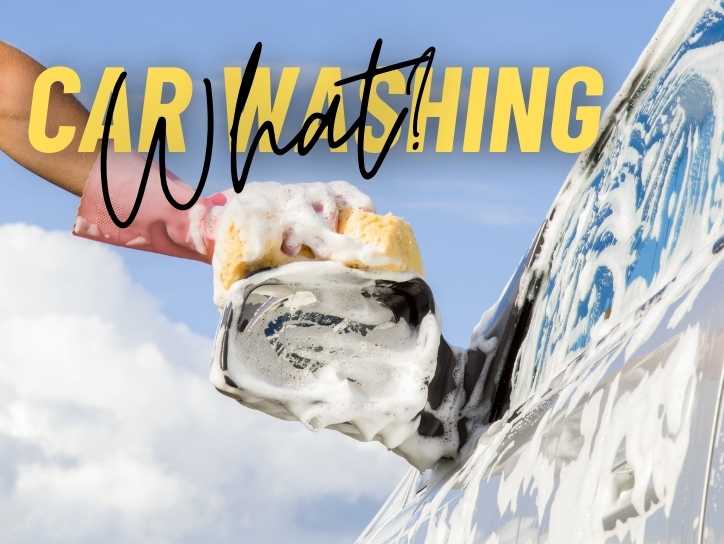Car washing is a routine maintenance practice aimed at cleaning the exterior and sometimes the interior of a vehicle. It involves the removal of dirt, grime, and contaminants that accumulate on the car’s surface during regular use.
While it may seem like a simple task, car washing plays a crucial role in preserving the aesthetics, functionality, and longevity of a vehicle. Did you know? Frank McCormick and J.W. Hinkle introduced “Automobile Laundry” in 1914.
Quick Definition
Car washing involves using water, soap, and cleaning agents to remove dirt, debris, and contaminants from a vehicle’s surface.
What’s the Importance of Car Washing?

Well, the importance goes beyond aesthetics; regular car washing is essential for several reasons. Let’s discuss them carefully:
- Preserving Paint and Finish: The car’s exterior is constantly exposed to various environmental elements, including dirt, bird droppings, tree sap, and road salts. These can damage the paint and finish over time. Washing the car regularly helps prevent corrosion and preserves the vehicle’s appearance.
- Maintaining Resale Value: A well-maintained, clean car generally has a higher resale value. Regular washing prevents the buildup of stains and damage that can diminish the vehicle’s appeal and market value.
- Preventing Rust and Corrosion: Road salts and other corrosive substances can lead to rusting, especially in areas prone to moisture. Car washing removes these corrosive agents, protecting the metal components and preventing rust formation.
- Enhancing Visibility: Clean windows and mirrors are crucial for driving safety. Regular car washing ensures clear visibility by removing dirt and grime that can obstruct the driver’s view.
- Improving Aerodynamics: Unnecessary dirt and debris on the car’s surface like underbody can create aerodynamic drag, affecting fuel efficiency. Keeping the car clean contributes to better aerodynamics and improved fuel economy.
Benefits of Regular Car Washing

- Improved Vehicle’s Aesthetics: A clean, well-maintained car looks more appealing. Regular washing removes dust, stains, and contaminants, enhancing the overall appearance of the vehicle.
- Protecting the Clear Coat: The clear coat on a car’s paint is a protective layer that can be damaged by contaminants. Regular washing helps preserve the clear coat, preventing premature wear and maintaining the paint’s integrity.
- Health and Safety: The interior of a car can harbour allergens, bacteria, and other contaminants. Regular interior cleaning, as part of the car washing routine, contributes to a healthier and safer driving environment.
- Preservation of Paint and Finish: Regular washing helps eliminate various contaminants such as dirt, dust, bird droppings, tree sap, and road salt. These substances can damage the paint and finish of the car over time.
- Prevention of Body Corrosion: If you live in an area where roads are salted during winter, regular washing is crucial. Salt can accelerate the corrosion of metal components, leading to rust. Washing the car helps remove salt deposits and protect the metal surfaces.
- Improved Resale Value: A clean and well-maintained car is more appealing to potential buyers. Regular washing helps preserve the car’s appearance, contributing to a higher resale value when you decide to sell or trade it in.
- Enhanced Visibility: Regular cleaning of windows and mirrors ensures clear visibility while driving. This is essential for safety on the road, especially during adverse weather conditions.
- Long-Term Mechanical Health: In addition to protecting the exterior, regular washing can also prevent corrosion of mechanical components under the car. This is particularly important if you live in an area with harsh weather conditions.
- Protects Against UV Damage: Exposure to sunlight over time can lead to fading and deterioration of the paint and interior materials. Regular washing, combined with waxing, provides a protective barrier against UV rays.
- Prolonged Lifespan: By removing contaminants and protecting surfaces, regular car washing contributes to the prolonged lifespan of various components, both inside and outside the vehicle.
- Reduced Maintenance Costs: Regular washing is a form of preventive maintenance. By taking care of your car’s exterior and interior, you may reduce the likelihood of more significant and costly repairs in the future.
Price Details of Car Washing
A car wash can cost anywhere between $3 to $500 depending on the location, services offered, and additional features.
| Type of Car Wash | Price Range |
| Self-Service | $3 – $10 |
| Automatic | $5 – $20 |
| Hand Car Wash | $15 – $50+ |
| Mobile Car Wash | $20 – $100+ |
| Detailing Services | $50 – $500+ |
Price of Car Washing in India
A basic car wash costs in the Indian market costs between Rs 200 to Rs 1500.
| Type of Car Wash | Price Range |
| Self-Service | Rs 246 – 820 |
| Automatic | Rs 410 – 1640 |
| Hand Car Wash | Rs 1230 – 4100 |
| Mobile Car Wash | Rs 1640 – 8200 |
| Detailing Services | Rs 4100- 41000 |
Different Types of Car Washing
Depending on your requirements and location, there are several types of car washing methods, each catering to different needs and levels of cleanliness. Below are some common types with their benefits:
1. Hand Washing
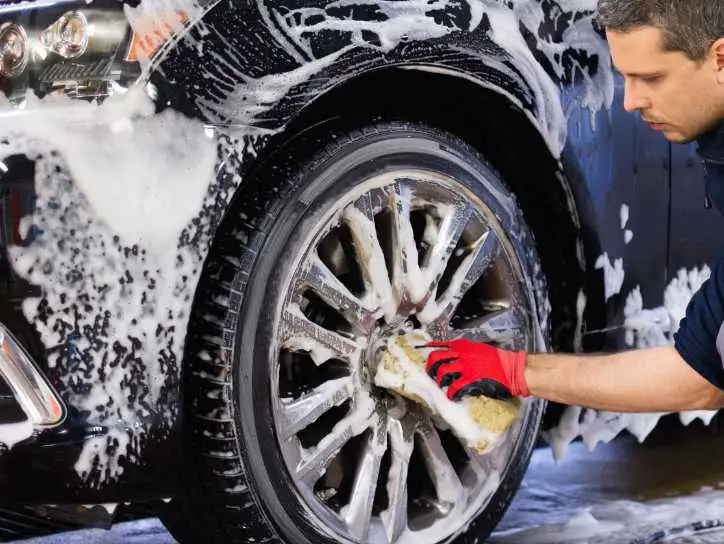
Hand washing involves an in-depth cleaning process using a bucket, a high-quality microfiber wash mitt or sponge, and an automotive-specific soap. It often includes a two-bucket method—one with soapy water and another with clean water to rinse the mitt.
Benefits:
- Allows for precise cleaning, especially in intricate areas.
- Minimizes the risk of scratches when performed with proper technique.
- Ideal for car enthusiasts who enjoy the hands-on aspect of car maintenance.
2. Automatic/Touchless Car Wash
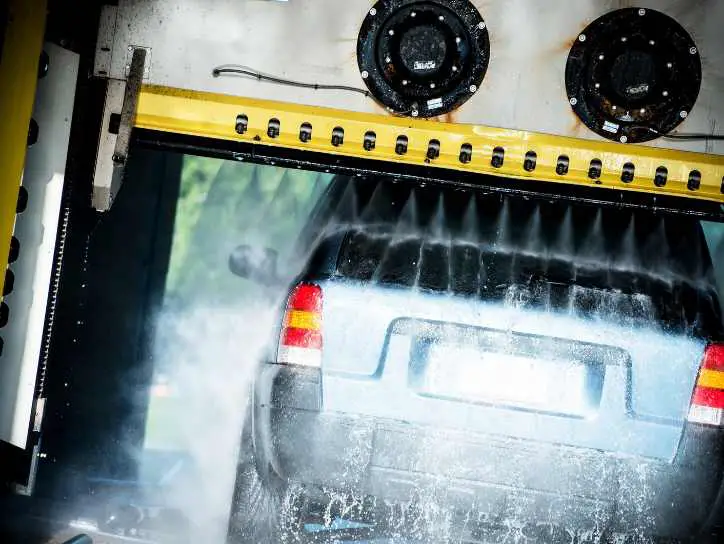
Automatic car washes utilize mechanized systems and conveyor belts to guide the vehicle through various cleaning stages. Touchless car washes rely on high-pressure water jets and cleaning agents without physical contact with brushes.
Benefits:
- Offers a quick and convenient cleaning solution.
- Reduced risk of scratches as there’s no direct contact with brushes.
- Additional features like undercarriage wash and wax application are often available.
3. Self-Service Car Wash
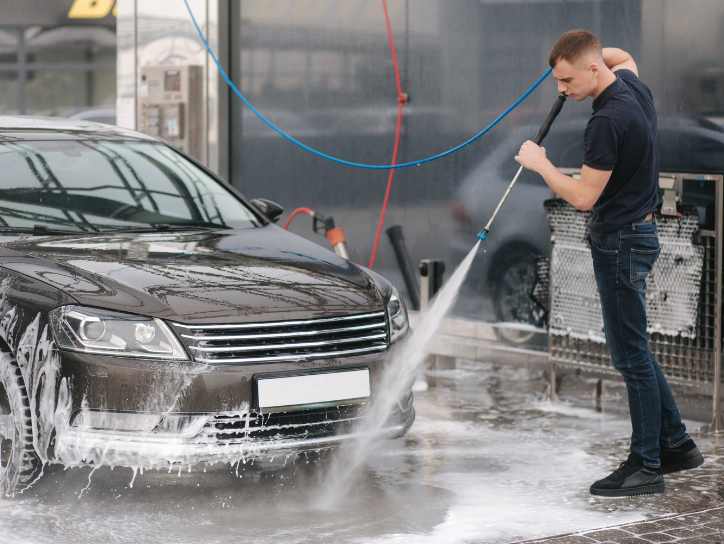
Self-service car wash facilities provide users with a range of cleaning tools such as pressure washers, foaming brushes, and vacuum stations. Customers have the autonomy to wash their vehicles.
Benefits:
- Users have control over the cleaning process, focusing on specific areas as needed.
- Can be cost-effective compared to other methods.
- Convenient for those who prefer a hands-on approach but lack the space or equipment at home.
4. Waterless Car Wash
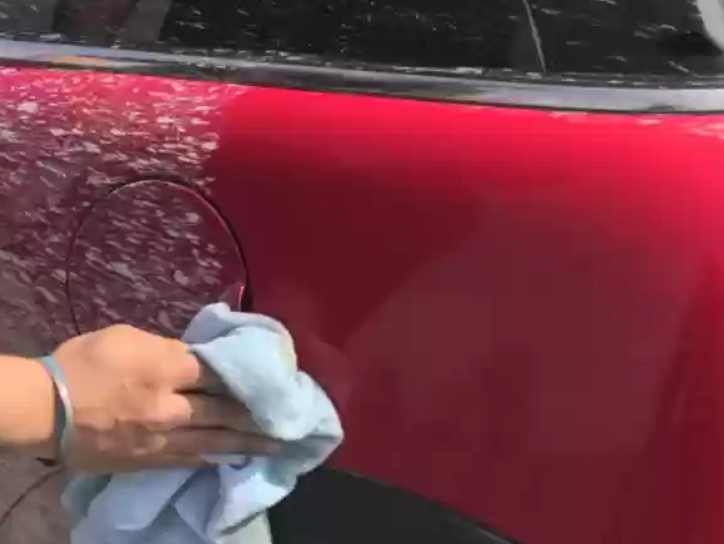
Waterless car wash products consist of specially formulated chemicals that lift and encapsulate dirt without the need for traditional water rinsing. The cleaner is sprayed onto the surface and wiped off with microfiber towels.
Benefits:
- Environmentally friendly as it conserves water.
- Convenient for areas with water restrictions.
- Quick and efficient for light dirt and dust.
5. Foam Cannon Wash

Foam cannons are attachments for pressure washers that spray a thick layer of foam onto the vehicle. The foam clings to the surface, encapsulating dirt and contaminants, making them easier to rinse off.
Benefits:
- Provides even coverage of cleaning products.
- Softens and lifts dirt, reducing the risk of scratches during washing.
- Adds a visual element to the cleaning process, enhancing the overall experience.
6. Detailing/Hand Waxing

Detailing involves an in-depth cleaning and restoration process for both the interior and exterior of the vehicle. Hand waxing, a component of detailing, includes manually applying a protective wax layer to enhance the paint’s appearance and durability.
Benefits:
- Restores and enhances the vehicle’s overall appearance.
- Offers a high level of protection against environmental elements.
- Attention to detail addresses specific cosmetic issues for a polished look.
7. Rinseless Car Wash

The Rinseless car washing method allows cleaning without a continuous water rinse. A concentrated solution is diluted, applied to the car, and wiped off without the traditional rinse process.
Benefits:
- Water-saving alternative to traditional washing methods.
- Suitable for situations where a full rinse is impractical.
- Can be done in confined spaces, making it convenient for apartment dwellers or those without easy access to a hose.
8. Steam Car Wash

Steam car washes utilize high-pressure steam to clean the vehicle. Steam effectively breaks down dirt and grime, and the process requires minimal water usage compared to traditional methods.
Benefits:
- Environmentally friendly due to low water usage.
- Efficient in removing tough stains and contaminants.
- Steam sanitizes surfaces, reducing bacteria and allergens in the vehicle.
9. Drive-Through Car Washing

A drive-through car wash is an automated system where cars get cleaned without manual labour. It’s commonly found at gas stations, standalone car wash facilities, or businesses dedicated to vehicle cleaning services.
Benefits:
- Quick and hassle-free, saving time for busy individuals.
- Automated precision ensures thorough and uniform cleaning of the entire vehicle.
- Efficient water usage and recycling contribute to environmental sustainability.
10. Underbody Car Wash

An underbody car wash specifically targets the underside of a vehicle. This type of car wash is designed to remove dirt, salt, and debris that accumulate on the undercarriage, helping to prevent corrosion and maintain the overall health of the vehicle.
Benefits:
- Removes salt and debris, extending the lifespan of the undercarriage.
- Enhances visibility and functionality of brakes and suspension for safer driving.
- Preventive maintenance reduces the risk of expensive repairs, saving money over time.
11. Full-Service Car Washing
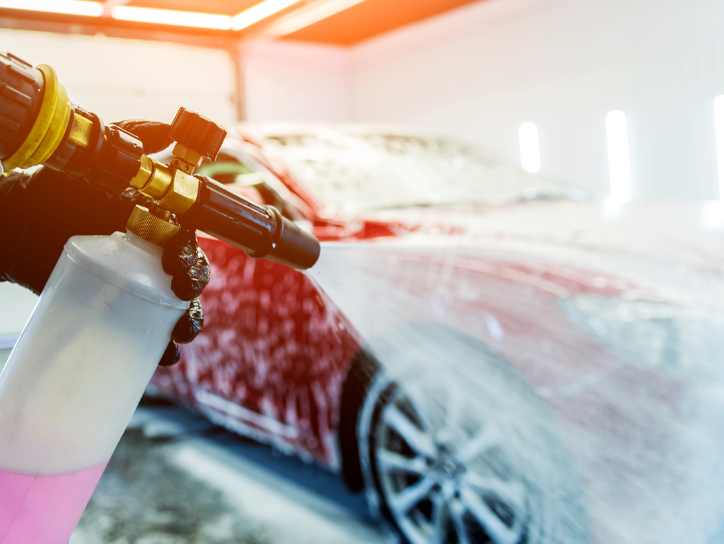
Full-service car washing is a comprehensive vehicle cleaning process that typically includes exterior cleaning, interior cleaning, and additional services such as waxing and detailing. It is often performed by professional car wash facilities.
Benefits:
- Offers a thoroughly refreshed interior and exterior for a revitalized look with mechanical checks.
- Maintain appearance for a lasting and more valuable impression.
12. Brushless Car Washing
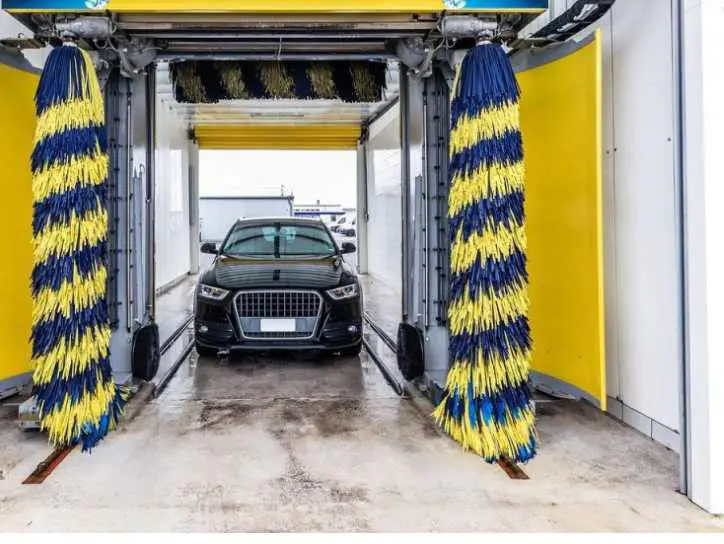
Brushless car washing is a cleaning method that utilizes high-pressure water jets, detergents, and sometimes air dryers to clean the vehicle’s exterior without the use of physical brushes or friction.
Benefits:
- Offers a gentle, scratch-free cleaning, safeguarding your vehicle’s pristine paint.
- You can choose this washing method for a quick, time-saving process, catering to the needs of busy car owners.
- Brushless washing is a cost-effective option with no brush replacement or maintenance expenses.
13. On-Demand Car Wash Service

On-demand car wash is a flexible cleaning solution that lets customers schedule a wash at their location. Professional cleaners are dispatched to provide the service.
Benefits:
- You can enjoy the convenience of scheduling a car wash at a time and location that suits your needs, saving time and effort.
- Eliminate the need to travel to a car wash facility, saving valuable time for busy individuals.
- On-demand services often prioritize water conservation, utilizing eco-friendly methods and water-saving techniques.
- Many on-demand services offer transparent pricing, allowing customers to know the cost upfront and avoid hidden fees.
Note: Choosing the right car washing service depends on various factors such as the available resources, time constraints, and personal preferences. Each method offers distinct advantages, and the choice may vary based on the specific cleaning needs of the vehicle at a given time.
Different Types of Car Washing Techniques
Unlike different car washing methods provided by different brands, a car washing technique is a blend of methods aimed at preserving appearance and ensuring durability. Usually, it is performed by car owners at their preferred location.
From traditional hand washing to advanced automation, these techniques play a crucial role in maintaining your vehicle’s aesthetic appeal and protecting it against the elements. Let’s understand common types:
1. Two-Bucket Method

The traditional two-bucket method involves using two separate buckets—one with soapy water and the other with clean water. The wash mitt or sponge is rinsed in the clean water bucket to remove dirt before reloading it with soap from the soapy water bucket.
Benefits:
- Minimizes the risk of introducing dirt and contaminants back onto the vehicle’s surface.
- Ensures a clean washing mitt for each section of the car.
2. Three-Bucket Method
It’s an extension of the two-bucket method, the three-bucket method includes an additional bucket for wheels and tires. This bucket is dedicated solely to cleaning wheel-related tools to prevent cross-contamination with the rest of the car.
Benefits:
- Ensures that contaminants from the wheels do not come in contact with the paint.
- Provides a dedicated space for wheel cleaning tools.
3. Grit Guard Bucket Method
This method incorporates a grit guard at the bottom of the wash bucket. The grit guard has raised fins that trap dirt and debris below the level of the wash mitt, preventing them from being picked up again during washing.
Benefits:
- Adds an extra layer of protection against reintroducing contaminants.
- Fins on the grit guard act as a barrier, keeping dirt away from the wash mitt.
4. Pre-Wash Bucket Method
Before starting the main wash, a pre-wash bucket is used to rinse the wash mitt and remove loose dirt and debris. This helps reduce the risk of scratching during the main wash.
Benefits:
- Removes larger particles that could otherwise cause scratches.
- Ensures a cleaner wash mitt when starting the main wash.
What’s the Proper Washing Order for Car Washing?

The proper washing order, commonly recommended by detailing experts and car care professionals, follows a systematic approach to ensure effective cleaning while minimizing the risk of introducing scratches or swirl marks. The general order for washing a car is top-down, and the wheels should be cleaned last.
Here’s the step-by-step washing order:
- Step 1: Rinse the Car: Start by rinsing the entire car with water. This helps remove loose dirt, dust, and contaminants from the surface, making the subsequent washing steps more effective.
- Step 2: Clean Wheels and Tires: Begin with the wheels and tires, as these areas tend to accumulate the most brake dust, dirt, and grime. Use a dedicated wheel cleaner, brushes, and a separate bucket for wheel cleaning to avoid cross-contamination with the rest of the car.
- Step 3: Pre-Wash or Pre-Rinse: Some car enthusiasts prefer a pre-wash or pre-rinse step using a specialized pre-wash solution. This step helps loosen and lift additional dirt before the main wash.
- Step 4: Top-Down Washing: Start washing from the top of the car and work your way down. This order is crucial to prevent dirt from the upper parts of the car from being dragged down onto already-clean sections. You can also read proper car washing orders.
Use the two-bucket method, with one bucket containing soapy water and the other clean water for rinsing the wash mitt or sponge. This helps minimize the risk of scratching the paint.
- Step 5: Rinse Frequently: Regularly rinse the wash mitt or sponge in the clean water bucket to remove accumulated dirt. Frequent rinsing helps prevent dirt particles from being reintroduced to the car’s surface.
- Step 6: Clean Lower Sections: As you progress downward, clean the lower sections of the car, including the sides and rear. Ensure thorough cleaning of all surfaces, including door jambs and other often overlooked areas.
- Step 7: Final Rinse: Once the entire car has been washed, give it a final thorough rinse. This helps remove any remaining soap and ensures a clean, spot-free finish.
- Step 8: Dry the Car: Use a clean, soft microfiber towel or chamois to dry the car. Start from the top and work your way down. Drying helps prevent water spots and gives the car a polished appearance.
- Step 9: Clean Glass and Mirrors: Use a glass cleaner to clean the windows and mirrors. Ensure streak-free visibility by using a high-quality microfiber cloth.
- Step 10: Apply Wax or Sealant (Optional): If desired, apply a protective wax or sealant to the clean, dry paint surface. This step enhances the shine and provides additional protection against environmental elements.
Steps to Choose the Right Cleaning Products for Your Car
- Consider car materials
- Check product labels
- Use mild cleaners
- Test a small area first
- Choose purpose-specific products
- Consider eco-friendly options
- Read about brands – reviews, ratings, etc.
- Avoid silicone-based products
- Use protective products
- Consider personal sensitivities
Choosing the right cleaning products for your car is crucial for maintaining its appearance and protecting various surfaces.
Car cleaning products can be categorized into different types, each serving a specific purpose.
Here’s an overview of the main categories and their subcategories:
Exterior Cleaning Products

1. Car Wash Soap: To safely and effectively remove dirt and contaminants from the car’s exterior.
- pH-Balanced Car Wash Soaps: Gentle on paint, suitable for regular use.
- Heavy-Duty Car Wash Soaps: Formulated for tougher dirt and grime.
2. Wheel and Tire Cleaners: To clean brake dust, road grime, and dirt from wheels and tires.
- Acid-free wheel Cleaners: Safe for various wheel finishes.
- Iron Fallout Removers: Specifically designed to remove iron particles from wheels.
3. Bug and Tar Removers: To remove bugs, tar, and other stubborn contaminants.
- Sprays or Wipes: Convenient for targeted applications.
4. Clay Bars and Lubricants: To remove embedded contaminants and provide a smooth surface.
- Fine Grade Clay Bars: Suitable for regular use.
- Heavy Grade Clay Bars: Used for more stubborn contaminants.
5. Quick Detailers: To enhance shine between washes and provide a quick cleaning solution.
- Spray Detailers: Convenient for quick applications.
6. Polishes and Compounds: To remove swirl marks, scratches, and restore the paint finish.
- Polishes: Used for minor imperfections.
- Compounds: More abrasive for deeper scratches.
7. Sealants and Waxes: To protect and enhance the car’s paint.
- Synthetic Sealants: Long-lasting protection.
- Carnauba Waxes: Provides a warm, natural shine.
Interior Cleaning Products

1. Interior Cleaners: To clean surfaces like the dashboard, seats, and door panels.
- All-Purpose Interior Cleaners: Versatile for various surfaces.
- Leather Cleaners: Specifically formulated for leather surfaces.
2. Carpet and Upholstery Cleaners: To clean and refresh carpets and fabric upholstery.
- Spray-on Cleaners: For spot cleaning.
- Foam Cleaners: For deep cleaning.
3. Glass Cleaners: To clean and provide streak-free clarity to windows and mirrors.
- Ammonia-Free Glass Cleaners: Safe for tinted windows.
- Foaming Glass Cleaners: Clings to vertical surfaces for easy cleaning.
4. Leather Conditioners: To nourish and protect leather surfaces.
- Water-Based Conditioners: For modern, coated leather.
- Oil-Based Conditioners: Suitable for older, untreated leather.
5. Air Fresheners: To eliminate odours and provide a pleasant interior fragrance.
- Spray Air Fresheners: Quick and easy application.
- Vent Clips and Diffusers: Continuous fragrance release.
Specialty Cleaning Products
1. Engine Bay Cleaners: To remove dirt, grease, and grime from the engine compartment.
- Water-Based Engine Cleaners: Safe for sensitive components.
2. Convertible Top Cleaners: To clean and protect convertible soft tops.
- Vinyl Convertible Top Cleaners: For vinyl tops.
- Fabric Convertible Top Cleaners: For fabric tops.
3. Headlight Restoration Kits: To remove oxidation and restore clarity to headlights.
- Abrasive Kits: Include sandpaper for more severe oxidation.
- Polishing Kits: Use compounds and polishes for milder cases.
4. Trim and Plastic Restorers: To restore and protect exterior plastic and trim.
- Spray-on Trim Restorers: Convenient for quick application.
- Gel-based Restorers: Provide longer-lasting protection.
Note: When choosing cleaning products, consider factors such as your car’s specific materials, your detailing goals, and any personal preferences. Always follow product instructions, and test new products in inconspicuous areas to ensure compatibility with your car’s surfaces.
Car Washing Products Terms for Owners
1. Car Shampoos and Soaps
Definition: A car shampoo is a specifically formulated detergent designed for washing vehicles. They help remove dirt, grime, and contaminants from the car’s exterior without causing damage to the paint.
2. Microfiber Cloths and Mitts
Definition: A car cleaning cloth is a soft, lint-free fabric made from microfiber material. These are used for gentle cleaning and wiping surfaces without scratching, making them ideal for various car detailing tasks.
3. Wheel Cleaners
Definition: A wheel cleaner is a specially designed product to remove brake dust, road grime, and other contaminants from the wheels and brake area. They may come in various formulations for different wheel types.
4. Drying Towels
Definition: Absorbent towels used to dry the car’s surface after washing. Typically made from microfiber, they help prevent water spots and streaks, leaving the vehicle with a clean and polished finish.
5. Interior Cleaners
Definition: A cleaning product formulated for the interior surfaces of a car, including seats, dashboard, door panels, and centre console. They help remove stains, spills, and dust without harming interior materials.
6. Glass Cleaners
Definition: A glass spray or liquid is a specially designed-cleaner for glass surfaces, such as windows and mirrors. They are formulated to remove streaks, smudges, and contaminants, providing clear visibility.
7. Tire Shine or Dressing
Definition: These Products are designed to enhance the appearance of tires by providing a shiny finish. Tire dressings often contain conditioners to protect against cracking and fading.
8. Clay Bars
Definition: Clay bars are used in the decontamination process to remove embedded contaminants on the car’s paint surface. They help create a smooth finish in preparation for waxing or sealing.
9. Wax or Sealant
Definition: A car wax is a protective polish that is applied to the car’s exterior after cleaning. Wax adds a layer of protection and enhances shine, while sealants provide longer-lasting protection against environmental elements.
10. Detailing Brushes
Definition: A car detailing is a small brush with soft bristles designed for delicate cleaning tasks. Detailing brushes are useful for cleaning vents, crevices, and other hard-to-reach areas.
11. Upholstery and Carpet Cleaners
Definition: These cleaners are formulated for fabric and carpeted surfaces inside the car. They help remove stains, spills, and odours, keeping the interior fresh and clean.
12. Bug and Tar Removers
Definition: It’s a specialized product to remove stubborn bug splatter, tar, and other road contaminants from the car’s exterior without damaging the paint.
13. All-Purpose Cleaner
Definition: An all-purpose car cleaner is suitable for various surfaces, both interior and exterior. They are formulated to handle a range of cleaning tasks without causing damage to specific materials. Usually, a vehicle owner purchases these kinds of cleaners because of practicality.
Types of Chemicals Used in Car Washing

- Surfactants: It helps reduce the surface tension, aiding in the removal of dirt and grime.
- Detergents (shampoo, soap, etc.): A detergent helps break down and lift away contaminants, including grease and oil.
- Acids (pH Adjusters): Mostly used in tire/wheel cleaning. It adjusts the pH level in wheel cleaners and bug/tar removers to enhance effectiveness.
- Alkaline Cleaners: It is used against organic stains, such as bird droppings and bug splatter.
- Enzyme Cleaners: They break down organic stains and odours, especially effective on upholstery.
- Water Softener: It reduces water hardness, preventing mineral deposits on the car’s surface after washing.
- Polish and Wax: It restores the shine by removing fine scratches and swirl marks, while wax protects the paint and provides a glossy finish.
Specialized Car Washing
Specialized car washing is a detailed approach that targets specific vehicle features, like convertible tops, headlights, and engine bays, addressing unique cleaning needs for enhanced appearance and component longevity.
1. Convertible Top Care
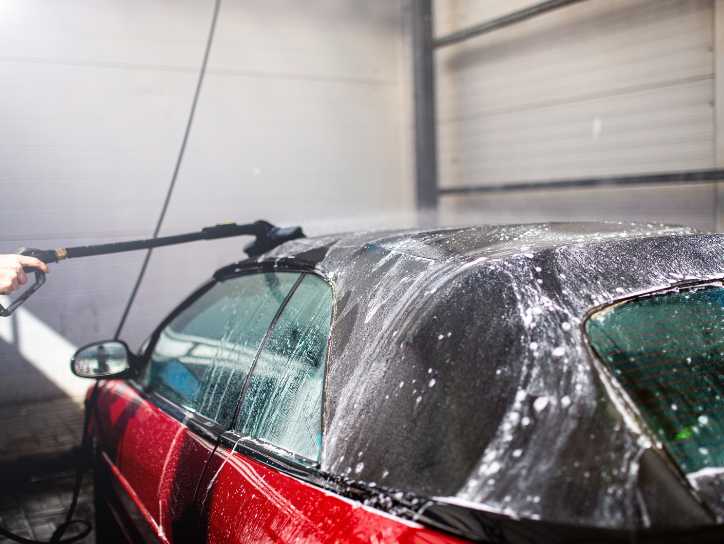
Convertible tops require special attention to maintain their appearance and functionality. Here are some tips for specialized care:
- Use Appropriate Cleaners: Choose a cleaner specifically designed for convertible tops. Avoid harsh chemicals that could damage the fabric or the waterproof coating.
- Soft Brush or Cloth: Gently scrub the convertible top with a soft brush or cloth to remove dirt and stains. Avoid abrasive materials that may scratch or tear the fabric.
- Waterproofing Treatment: Periodically apply a waterproofing treatment to maintain the convertible top’s water resistance. Follow the product instructions for the best results.
- Avoid Direct Sunlight: Whenever possible, park your convertible in the shade or use a car cover to protect the top from prolonged exposure to sunlight, which can cause fading and damage.
2. Headlight Restoration
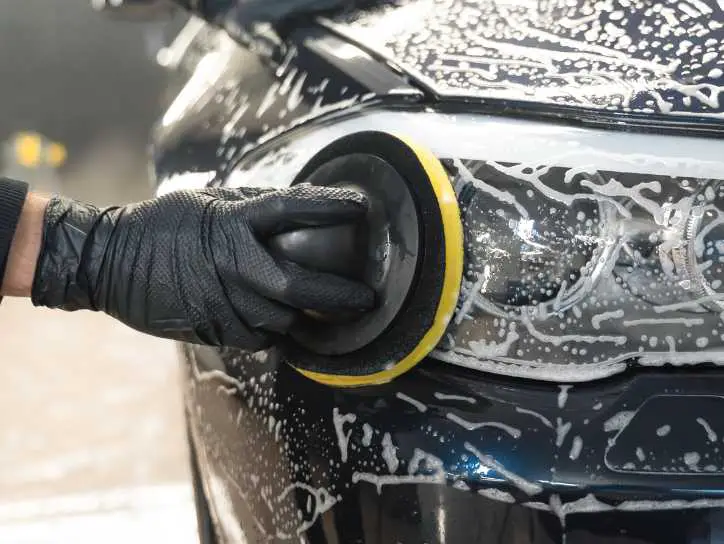
Headlight restoration enhances visibility and improves the overall appearance of your vehicle. Here’s how to do it:
- Clean the Headlights: Begin by cleaning the headlights with a mild soap or headlight cleaning solution and a soft cloth. Remove any dirt or grime that may be on the surface.
- Use a Headlight Restoration Kit: Invest in a quality headlight restoration kit that includes sandpaper, a polishing compound, and a sealant. Follow the kit’s instructions for step-by-step guidance.
- Polishing: Use the provided polishing compound to remove scratches and restore clarity to the headlights. This step may involve using progressively finer grits of sandpaper.
- Apply Sealant: Finish the process by applying a UV-resistant sealant to protect the headlights from future damage and oxidation.
3. Engine Bay Cleaning
Cleaning the engine bay not only improves the overall aesthetic but also helps identify potential issues. Here’s how to do it safely:
- Cool Engine: Ensure that the engine is cool to the touch before starting the cleaning process. A hot engine can cause cleaning products to evaporate quickly, leaving residues.
- Cover Sensitive Components: Cover electrical components, such as the battery and fuse box, with plastic bags to prevent water damage.
- Use a Degreaser: Apply a degreaser to the engine components and let it sit for a few minutes. Use a soft brush or cloth to scrub away dirt and grime.
- Rinse Thoroughly: Use a gentle stream of water or a low-pressure hose to rinse off the degreaser. Avoid using a high-pressure washer, as it may force water into sensitive areas.
Precautions and Tips for Special Cars
- Avoid High-Pressure Water: High-pressure water can force water into sensitive electrical components. Use a low-pressure hose or a watering can to minimize the risk.
- Protect Electrical Components: Cover sensitive components with plastic bags or plastic wrap to prevent water damage during the cleaning process.
- Disconnect the Battery: For an extra layer of precaution, disconnect the car battery before cleaning the engine bay. This reduces the risk of electrical damage.
- Use Appropriate Products: Choose engine bay cleaning products that are safe for rubber, plastic, and metal components. Avoid strong solvents that may damage the materials.
- Dry Thoroughly: After cleaning, allow the engine bay to dry thoroughly before starting the engine. This helps prevent electrical issues and ensures a clean finish.
Water Conservation in Car Washing
Water conservation in car washing is vital for sustainability. This overview emphasizes the importance of eco-friendly products, water recycling, and efficient techniques for minimizing water usage.
1. Eco-Friendly Car Washing Products
Choose eco-friendly car wash products like biodegradable soaps, waterless sprays, and phosphate-free cleaners. Opt for plant-based or organic formulas to minimize the environmental impact of car washing.
2. Water Recycling Systems
When washing your car, choose eco-friendly, biodegradable soaps and detergents to minimize environmental impact. Alternatively, try waterless car wash products that require minimal water usage. To reduce pollution, opt for phosphate-free cleaners and consider plant-based or organic formulas.
3. Tips for Water-Efficient Car Washing
To reduce the environmental impact of car washing, adopt water-efficient practices. Use a bucket and sponge or a trigger nozzle on a hose to control water flow. Wash during off-peak times and reduce the frequency of car washes through regular vehicle maintenance. Capture and reuse excess water for non-potable purposes.
What is the Recommended Schedule for Car Washing?
It’s generally recommended to wash your car every one to two weeks to prevent the accumulation of dirt, bird droppings, and other contaminants that can harm the paint. Additionally, a monthly interior cleaning routine is also recommended as it helps maintain a clean and comfortable inside.
This frequency strikes a balance between preserving the vehicle’s finish and minimizing water usage. Adjustments can be made based on local weather conditions, driving habits, and environmental factors.
Factors Influencing Your Car Washing Frequency
The frequency of car washing depends on factors such as the local environment (industrial activity, pollution), weather conditions (rain, snow, sunlight), vehicle usage (distance, off-road driving), parking conditions (under trees, near construction), etc. Adjusting your washing schedule based on these factors helps maintain your car’s appearance and condition.
Car Washing Tips for Car Owners

Below are some simple tips that can be followed by any vehicle owner to wash their vehicle:
- Water-Efficient Techniques: Utilize a bucket and sponge instead of a running hose to minimize water waste during car washing.
- Eco-Friendly Products: Choose biodegradable soaps, waterless wash solutions, and phosphate-free cleaners to reduce environmental impact.
- Regular Maintenance: Keep your vehicle well-maintained to reduce the frequency of car washes, saving water and preserving the finish.
- Off-Peak Washing: Opt for car washing during off-peak hours to alleviate pressure on local water supply systems.
- Trigger Nozzle Usage: Attach a trigger nozzle to your hose to control water flow and use only as much water as needed.
- Closed-Loop Systems: Consider installing closed-loop water recycling systems to capture and reuse water for subsequent washes.
- Rainwater Harvesting: Explore the option of harvesting rainwater for car washing, providing a sustainable water source.
- Microfiber Towels: Use microfiber towels for drying, as they are more absorbent and require less water compared to traditional materials.
- Shade for Washing: Choose a shaded area for car washing to prevent water and cleaning products from drying too quickly, ensuring a more effective wash.
- Wheel and Tire Care: Pay attention to wheels and tires, as they often collect more dirt. Use dedicated cleaners and brushes for efficient cleaning.
- Capture and Reuse Water: Place containers strategically to capture excess water during washing for non-potable purposes like watering plants.
- Two-Bucket Method: Adopt the two-bucket method – one for soapy water and one for rinsing – to minimize dirt transfer and enhance cleaning.
- Gentle Cleaning Tools: Choose soft sponges, mitts, or brushes to avoid scratches, preserving the paint and finish of the vehicle.
- Trim and Interior Care: Extend cleaning efforts to trims and interiors, maintaining an overall well-kept appearance.
Car Washing Safety Tips for Vehicle Owners

- Choose a Safe Location: Select a well-lit and level area for car washing to ensure visibility and stability.
- Check the Weather Forecast: Avoid washing your car during adverse weather conditions to prevent slipping or discomfort.
- Use Slip-Resistant Mats: Place slip-resistant mats near water sources to minimize the risk of slipping.
- Wear Protective Gear: Use gloves and appropriate clothing to protect your hands and skin from chemicals and contaminants.
- Eye Protection: Consider wearing safety glasses or goggles to shield your eyes from splashes and debris.
- Mindful Product Handling: Follow product instructions, and be cautious when handling chemicals to avoid skin irritation or eye contact.
- Proper Ladder Use: If reaching high areas, use a stable ladder and follow safety guidelines to prevent falls.
- Electrical Safety: Keep electrical tools and extension cords away from water sources to prevent electrical hazards.
- Secure Loose Clothing: Tie back loose clothing and secure accessories to avoid entanglement in moving parts.
- First Aid Kit Availability: Keep a basic first aid kit on hand in case of minor injuries, and know the location of the nearest emergency facilities.
- Be Mindful of Surroundings: Stay aware of your surroundings, including potential tripping hazards or obstacles.
- Safe Storage of Tools: Store cleaning tools securely to prevent accidents and ensure a tidy workspace.
- Child and Pet Safety: Keep children and pets at a safe distance during the car washing process to avoid accidents.
- Emergency Preparedness: Familiarize yourself with emergency procedures and the location of safety equipment, such as fire extinguishers.
- Proper Lifting Techniques: When lifting heavy objects, use proper lifting techniques to avoid strain or injury.
Different Steps to Search for the Best Car Cleaning Services
- Define Your Needs: Determine the level of cleaning required.
- Online Search: Use search engines and online platforms.
- Read Reviews: Check Google Reviews, Yelp, and car service review sites.
- Ask for Recommendations: Seek advice from friends, family, or online communities.
- Check Social Media: Explore local groups for recommendations.
- Visit Websites: Check service providers’ websites for information.
- Compare Services and Prices: Evaluate offerings, pricing, and discounts.
- Check Certifications: Look for affiliations with industry organizations.
- Inquire About Products: Ask about cleaning products and techniques.
- Visit Location: Assess the cleanliness and professionalism of the facility.
- Check for Insurance: Ensure the service has proper insurance coverage.
- Ask Questions: Contact services directly to address any concerns.
- Look for Specialized Services: Ensure they offer specific services you may need.
- Consider Convenience: Evaluate location and operating hours.
- Book a Trial Service: Test the service with a basic package before committing.
FAQs
How do I remove bird droppings or tree sap from my car?
Promptly rinse off bird droppings or tree sap with water. If they have dried, use a specialized bug and tar remover or a mixture of water and mild soap. Gently rub the affected area with a soft cloth or sponge.
Can I use a dishwashing sponge to wash my car?
It’s not recommended. Dishwashing sponges can be abrasive and may scratch the paint. It’s better to use a soft microfiber sponge or mitt designed for car washing.
What should I do if I notice swirl marks on my car after washing?
Swirl marks are often caused by using a dirty sponge or cloth. To prevent them, ensure your washing tools are clean and free of debris. You can use a specialized swirl remover polish to diminish the appearance of existing swirl marks.
Are automatic car washes safe for my vehicle?
Automatic car washes can be convenient, but some types may use brushes that can scratch the paint. Touchless or brushless car washes are generally safer for your vehicle’s finish. If you choose an automatic wash, make sure it is well-maintained and uses soft materials.
Can you use a pressure washer to wash my car?
Yes, you can use a pressure washer, but it’s essential to use a low-pressure nozzle and keep a safe distance to prevent damage to the paint and other surfaces. Always follow the manufacturer’s guidelines for both the pressure washer and your car.
What is the purpose of a car wash?
The primary purpose of a car wash is to clean and maintain the exterior of a vehicle, removing dirt, grime, and contaminants to preserve its appearance and protect the paint.
Can you wash a car daily?
Washing a car daily is generally unnecessary and can be excessive. Depending on factors like weather conditions and usage, a weekly or bi-weekly wash is often sufficient.
Do car washes damage paint?
While modern car washes are designed to be safe for most vehicles, certain types, such as abrasive automatic brushes, can potentially cause damage to paint over time. Hand washing or touchless car washes are often gentler options.
Can I use regular household soap to wash my car?
No, it’s not recommended. Household soaps can strip away the wax and damage the paint on your car. It’s best to use a dedicated car wash soap that is specifically formulated for automotive paint.
Should I wash my car in direct sunlight?
It’s better to avoid washing your car in direct sunlight, especially on hot days. The sun can cause the soap to dry quickly, leaving streaks and water spots on your car. Try to wash your car in the early morning or late afternoon when the sun is less intense.
Conclusion
Car washing isn’t just for looks; it’s crucial for maintaining your vehicle.
Regular washes protect paint and extend your car’s life.
Recognizing this importance keeps your vehicle clean and well-kept, showcasing your pride of ownership.
Hope this guide helped you understand car washing.
Please feel free to share your questions or suggestions with me in the comments section below.
